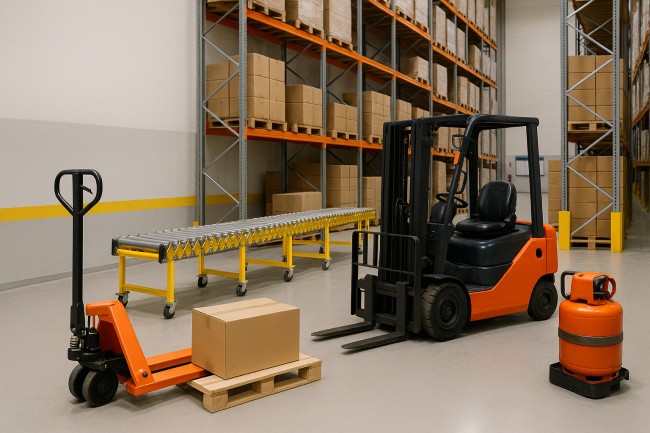Streamlining Warehouse Operations: Must-Have Tools and Tech for Peak Performance

Warehouse efficiency doesn’t just happen—it’s built on smart planning, the right equipment, and technology that reduces friction. Whether you’re managing a small distribution center or a large-scale logistics hub, streamlining operations starts with the tools you rely on daily.
Let’s break down the equipment that makes a real difference, not just in speed, but in safety, accuracy, and long-term profitability.
The Core Importance of Equipment in Warehouse Efficiency
Every delay in a warehouse comes with a cost. That might mean slower order fulfillment, mismanaged inventory, or even safety incidents. Often, these issues aren’t the result of poor staff performance—they stem from outdated or inappropriate equipment.
High-quality machines and equipment like using a heavy-duty platform trolley ensure smooth operations, reduce manual errors, and create consistency across shifts. They help standardize processes, which becomes increasingly important as order volume grows. In other words, great equipment is a multiplier: it makes everything (and everyone) better.
Pallet Jacks and Forklifts: The Backbone of Movement
Movement is constant in a warehouse. Whether it’s loading incoming stock or preparing outbound orders, you need reliable ways to shift products efficiently.
Manual pallet jacks are affordable and easy to use, perfect for tight spaces and short distances. But as volume increases, electric pallet jacks or forklifts become essential. They significantly cut down on worker fatigue and speed up material handling.
Forklifts, in particular, are workhorses. They’re built for heavier loads and vertical storage systems. When choosing one, consider your warehouse layout, ceiling height, and the weight of goods you typically move. You also want to ensure that staff are properly trained—forklift safety is no place for shortcuts.
Conveyor Systems: Automating the Routine
For medium to large warehouses, conveyor systems are a game changer. They automate repetitive transport tasks, reducing reliance on forklifts and manual labor for short hauls.
There are several types:
- Gravity conveyors use slight inclines and require no power.
- Motorized conveyors allow for direction control and higher throughput.
- Flexible conveyors adjust in shape to fit different spaces.
The key is identifying which stage of your process can benefit most—receiving, packing, or shipping—and scaling from there.
Racking and Shelving: Strategic Storage is Faster Storage
A disorganized warehouse bleeds time. Well-structured racking systems do more than hold products—they optimize floor space and improve picking accuracy.
Consider:
- Selective racking for easy access to all pallets.
- Drive-in racking for storing large volumes of the same item.
- Cantilever racking for long, awkward loads like piping or timber.
In addition to the system, your shelving layout should match the flow of your operations. Frequently picked items should be near the front and at waist height. Slower-moving stock can live higher up or further back.
Labeling and barcode integration with inventory software can also minimize mis-picks and speed up audits.
Attachments and Accessories: Small Add-ons, Big Impact
Sometimes, a simple attachment can significantly boost your workflow. Take the forklift trailer hitch as an example. It transforms your forklift into a multi-use tool capable of towing carts, trailers, or equipment across the warehouse floor. Instead of requiring a separate towing unit, your forklift can handle both lifting and pulling tasks—streamlining logistics and cutting down equipment costs.
Other useful accessories include:
- Lift tables for reducing strain during packing or assembly.
- Stretch wrap machines to secure outgoing pallets quickly.
- Drum handlers for safer, more efficient liquid transport.
These accessories may seem secondary, but in practice, they prevent injuries, reduce downtime, and keep workflows fluid.
Warehouse Management Systems (WMS): Your Digital Backbone
Physical equipment is vital—but digital tools are the glue that binds operations together.
A Warehouse Management System (WMS) tracks inventory in real time, optimizes picking routes, automates reordering, and integrates with shipping partners. In today’s fast-moving supply chain, real-time data isn’t a luxury—it’s a necessity.
Cloud-based platforms like Oracle NetSuite offer scalable WMS solutions that can support everything from order tracking to predictive analytics. This allows managers to spot inefficiencies quickly and make better decisions, faster.
Even basic WMS tools can significantly reduce stockouts, mis-picks, and shrinkage. It’s an investment that pays off—both in day-to-day operations and long-term growth.
Safety Gear and Ergonomic Tools: Investing in People
Tools and tech are essential, but people still drive your operation. Their health, safety, and productivity should never be afterthoughts.
At a minimum, invest in:
- High-visibility vests, gloves, helmets, and steel-toed boots.
- Anti-fatigue mats in standing workstations.
- Ergonomic hand tools that reduce wrist and back strain.
Injuries don’t just hurt workers—they disrupt your entire system. A well-equipped warehouse isn’t just faster. It’s safer, too.
Putting It All Together
Streamlining your warehouse isn’t about one magic tool—it’s about selecting the right combination of equipment and systems that support your daily flow. Start by identifying bottlenecks. Is product movement too slow? Are picking errors too frequent? Do employees struggle with outdated tools?
Once you have clarity on the pain points, matching them to the right solution becomes easier. With the right setup—pallet jacks, racking, WMS software, and intelligent accessories—your warehouse becomes a well-oiled machine.
Efficiency isn’t just about speed. It’s about working smarter, keeping your people safe, and setting up systems that scale with your business.

